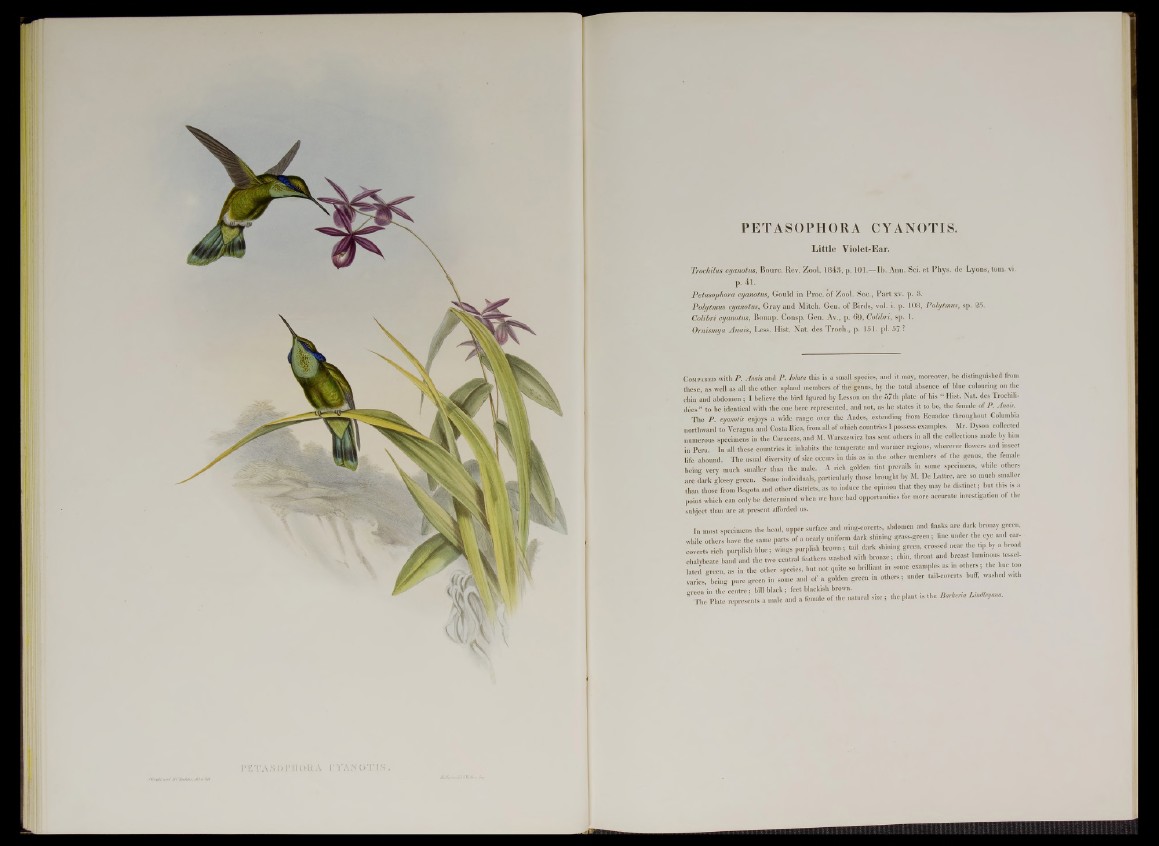
PETASOPHORA CYANOTIS.
Little Violet-Ear.
Trochilus cyanotus, Bourc. Rev. Zool. 1843, p. lO l S l b . Ann. Sci. et Phys. de Lyons, tom. vi.
p. 41.
Petasophora cyanotus, Gould in Proc. of Zool. Soc., P a rt xv. p. 8.
P o ly tm u s cyanotus, Gray and Mitcb. Gen. of Birds, vol. i. p. 108, Polytmus, sp. 25.
Colibri cyanotus, Bonap. Consp. Gen. Av., p. 69, Colibri, sp. 1.
Ornismya Anais, Less. Hist. Nat. des Troch., p. 151. pi. 571
Compared with P. Amis and P. Iolota this is a small species, and it may, moreover, be distinguished from
these, as well as all the other upland members of the-genus, by the total absence of blue colouring on the
chin and abdomen ; I believe the bird figured by Lesson on the 57th plate of his “ Hist. Nat. des Trochili-
dees ” to be identical with the one here represented, and not, as he states it to he, the female of P. Anais.
The P. cyanotis enjoys a wide range over the Andes, ¿¡tending from Ecuador throughout Columbia
northward to Veragua and Costa Rica, from all of which countries I possess examples. Mr. Dyson collected
numerous specimens in the Caraccas, and M. Warszewicz has sent others in all the collections made by him
in Peru In all these countries it inhabits the temperate and w a rie r regions, wherever flowers and insect
life abound The usual diversity of size occurs in this as in the other members of the genus, the female
being very much smaller than the male. A rich golden tint prevails in some specimens, while others
are dark glossy green. Some individuals, particularly those brought by M. De Lattre, are so much smaller
than those from Bogota and other districts, as to induce the opinion that they may be distinct; but this is a
point which can only be determined when we have had opportunities for more accurate investigation of the
subject than are at present afforded us.
In most specimens the bead, upper surface and wing-coverts, abdomen and flanks are dark bronzy green,
while others have the same parts of a nearly uniform dark shining grass-green; line under the eye and ear-
coverts rich purplish blue; wings purplish brown ; tail dark shining green, crossed near the tip by a broad
chalybeate band and the two central feathers washed with bronze; chm, throat and breast luminous tessellated
green, as in the other species, but not quite so brilliant in some examples as in others; the hue too
varies being pure green in some and of a golden green in others; under tail-coverts buff, washed with
green in the centre; bill black; feet blackish brown.
The Plate represents a mule and a female of the natural size ; the plant is the Barkena Ltndteyam.